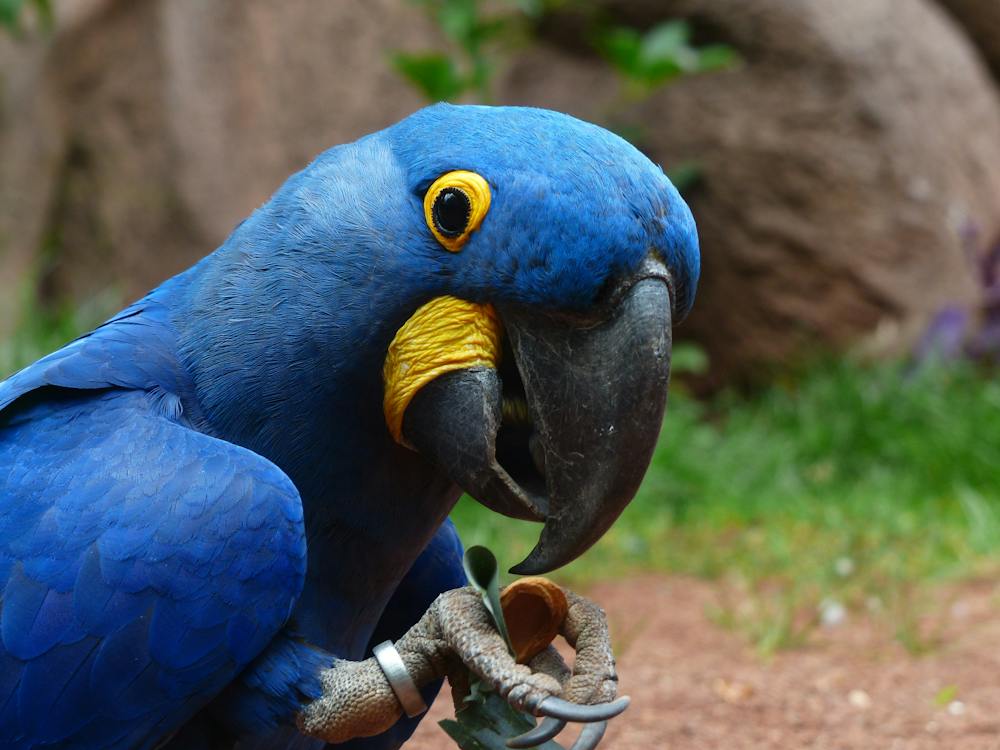The Hyacinth Macaw, also known as Hyachinthine Macaw and Anodorhynchus hyacinthinus, is a parrot endemic to eastern and central South America. This bird is touted as the largest macaw and the largest flying parrot species in the world. In the wild, Hyacinth Macaws are classified as Vulnerable on the IUCN Red List, which also makes them somehow rare in the pet trade. Therefore, taking good care of this striking, cobalt-blue parrot is exclusively for dedicated, experienced pet owners. If you believe you are one of them, make sure to read further to find out more information about Hyacinth Macaws!
History
English ornithologist John Latham was the first person to describe and cataloged the Hyacinth Macaw in 1790, and since then, the population numbers in the wild have been in a constant decline due to habitat loss, hunting, and rising demand in the pet trade. In the wild, they live in the scrublands, rainforests, and grasslands. There are only an estimated 2,500 to 5,000 Hyacinth Macaws wandering in the wild today. This bird species is a member of many conservation programs, all of which aim to preserve their continuously declining population.
Despite having beautiful features, Hyacinth Macaws are both rare in the wild and pet trade because their development is much slower compared to other parrots.
Characteristics of a Hyacinth Macaw
Average length: 40 inches from head to tail
Average life span: Can live up to 60 years with proper care
The Hyacinth Macaw is probably the most distinctive bird among the macaw family—it is even considered as the “Great Dane” of companion birds. It has a stunning cobalt-blue color all over its body, and the corners of its beak and the areas around its eyes are yellow in color.
The Hyacinth Macaws have enormous size—they are twice the size of an average macaw, which may frighten companion birds. Despite its domineering size, Hyacinth Macaws are gentle in nature. They can be easily trained by positive reinforcement and tend to bond closely with their human owners.
These birds have a wide variety of vocalizations, ranging from deep growls, high trills, to loud screeches. They tend to become noisy when around a large flock.
Caring for a Hyacinth Macaw
This bird species may be quite handful to care for, so before looking for a breeder, check with animal rescue organizations and adoption institutions for available Hyacinth Macaws. They are not commonly sold in pet stores due to their scarcity, so you can check professional breeders.
The Hyacinth Macaw is a needy parrot—it requires more attention than other birds. Truly, this bird is not for the faint of heart. It would demand a long-time commitment to take good care of this bird.
As you can expect from a large bird, your Hyacinth Macaw would require a spacious area to live. Very large enclosures are rare in pet shops; therefore, many owners find that custom-designed cage is essential. Most regular cages can be quickly destroyed by Hyacinth Macaw’s powerful beak, so it’s best to have a cage made of stainless steel. If you can, you can dedicate a room for your pet bird. Your pet can be destructive, so expect replacing wooden toys, branches, and other items frequently.
Like other parrots, Hyacinth Macaws are very sociable birds. They require a lot of interaction to be emotionally fulfilled. They are not “loners,” and will become depressed without a companion. When neglected, they can be destructive and self-mutilating. Therefore, make sure they receive so much attention.
Hyacinth Macaws have a wingspan that reaches 4 feet—they must be given ample time to exercise and a good space to stretch their wings. A minimum of one to two hours daily on a play gym should suffice to maintain their bone health. They like to chew to maintain jaw and beak health, so make sure to provide a variety of chew toys that have pieces of leather in them.
In the wild, these birds love feeding on nuts, fruits, and green vegetation. In captivity, Hyacinth Macaws survive by eating a variety of fresh fruits, vegetables, leafy greens, and nuts, specifically the macadamia nut, because they require more carbohydrates than other parrot species. Supplement your pet’s diet with specialized pellets.

